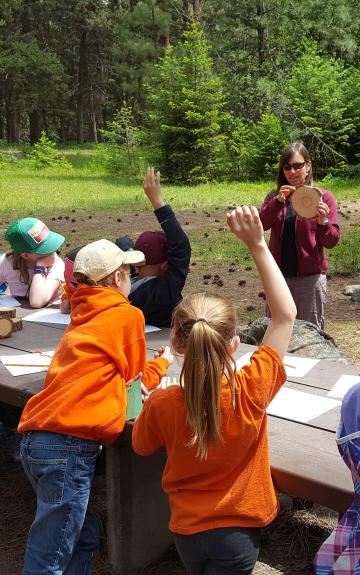Ilana Abrahamson continues to grow FireWorks curriculum
COLORADO—The FireWorks curriculum, developed at the Rocky Mountain Research Station, has brought the science of wildland fire to life in classrooms across the western United States for more than two decades. Children living in the wildland-urban interface often grow up with the reality of wildland fire right in their backyards. Many students, however, rarely have an opportunity to learn about fire behavior, ecology or preparedness. Recently, station ecologist Ilana Abrahamson received the National Gifford Pinchot Excellence in Interpretation and Conservation Education Award for her role in managing the FireWorks program.
“Through her dedication to conservation education, Ilana is contributing to the development of a public that understands and appreciates the nuance of fire science and fire management decisions,” said Thomas Dzomba, the deputy program manager for the station’s Fire, Fuel, and Smoke science program. “Perhaps the largest demonstration of Ilana’s professional excellence and leadership is the enthusiasm by which her staff and other volunteers embrace each opportunity to provide FireWorks education to students and teachers.”
Under Abrahamson’s leadership, the program has continued to grow. Specialized curricula have now been developed for the northern Rocky Mountains and Northern Cascades, Sierra Nevada, Missouri River Country, Cross Timbers ecoregion and sagebrush ecosystems, and several more are under development. Abrahamson and her colleagues also developed a generic version of the program that can be adapted for any environment where fires burn. An additional activity explores how and why the Pikunii (Blackfeet) people carried fire.
“I strongly believe that communicating about wildland fire science is critical in building public awareness, appreciation and even empowerment around wildland fire,” said Abrahamson. “I feel so lucky that I get to manage this amazing program, and I am grateful that RMRS and the Missoula Fire Sciences Laboratory support it. I see conservation education as a critical part of who we are as an agency, and I would love to see investment in conservation education grow alongside the increased visitation to our national forest lands.”
FireWorks provides teachers and students with interactive lesson plans and trunks of materials to help students understand the physical science of fire, the important role that fire plays in many ecosystems, and how human activities can influence fire. The program features engaging, hands-on activities, like the popular “Matchstick Forest,” which lets students see firsthand how factors like slope and fuel density affect fire spread. Curricula are available for grades K-12 and are updated to include the latest science and educational standards. The program is widely used by teachers and fire educators across the West—in the Missoula area alone, the program reaches more than 1,400 students and 300 adults each year.

